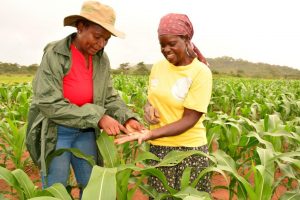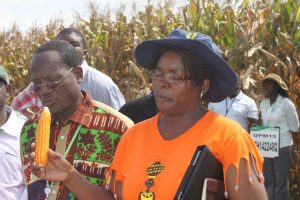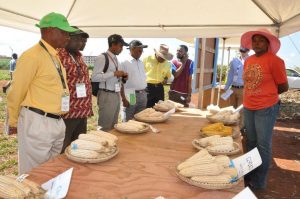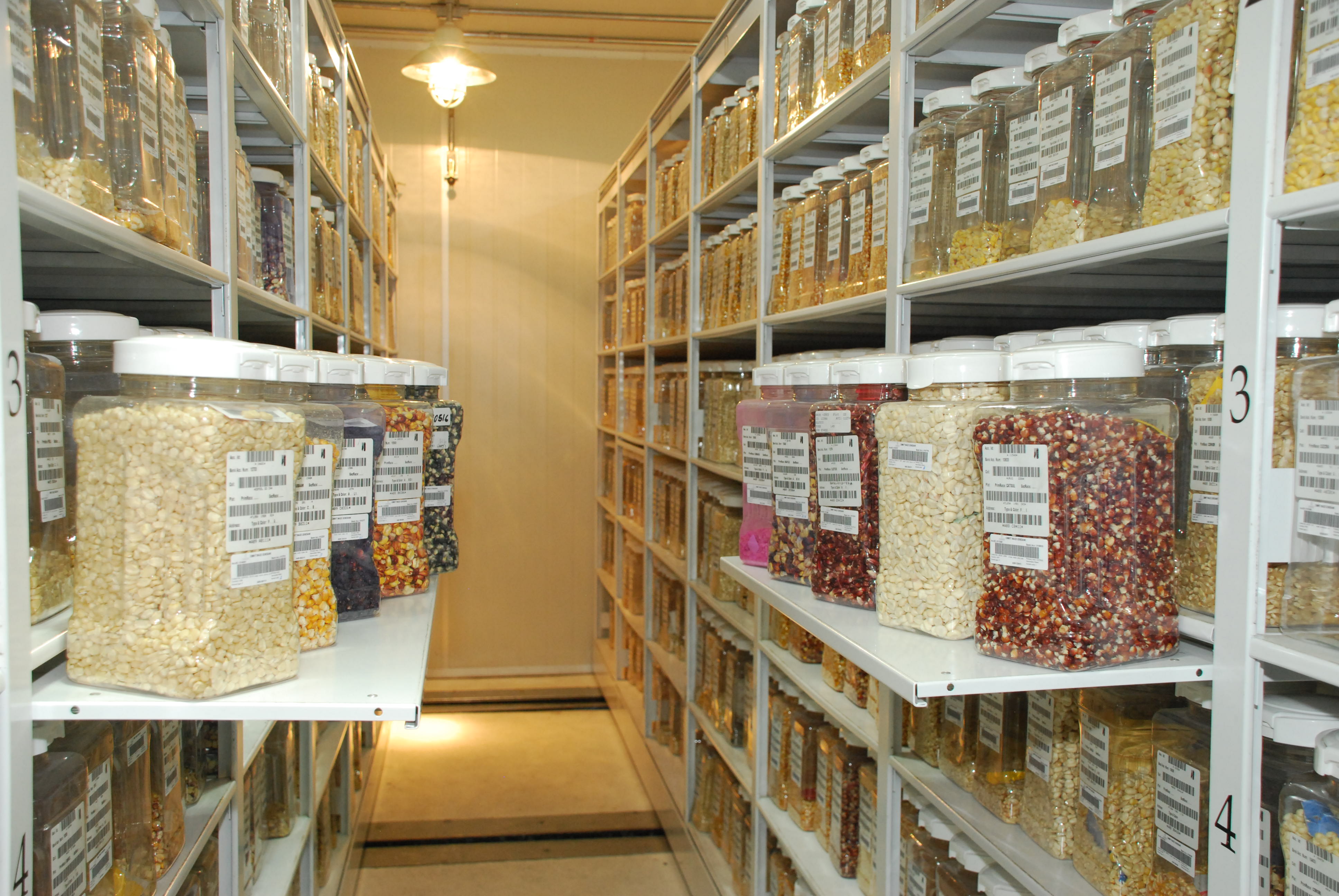
HARARE, Zimbabwe (CIMMYT) – Little did 47-year-old Thokozile Ndhlela know that growing up in a rural area in Zimbabwe would inspire her to become a well-respected agricultural scientist, helping to transform agriculture by developing science-based solutions to some of the complex issues facing African farmers.
Currently a postdoctoral staff member with the International Maize and Wheat Improvement Center (CIMMYT)in Zimbabwe’s capital Harare, Ndhlela encourages girls to choose options that lead to careers in agriculture. Most farmers worldwide average an age of over 60, so Ndhlela’s work is also helping to encourage young people to get involved in agriculture.
“There are many exciting opportunities to further improve agricultural productivity and improve food and nutritional security in my country, and beyond,” she said with a chuckle.
She comes from humble beginnings – growing up on a small farm, through primary and secondary school, and universities – and now she has begun to reap the rewards of her hard-won endeavors.
She credits her farmer father as her inspiration to pursue agricultural science.
“My father was my greatest source of inspiration for me to venture into agriculture,” Ndhela said. “From high school, he encouraged me to study sciences. He used to boast, saying his daughter would be studying agriculture and that I’d come back and assist him in his plot.”
His dream came true.
“I’m proud now since he is growing improved maize varieties that l’m providing him,” she said, adding that he proudly tells his friends that the varieties are being bred by his daughter.

For Ndhlela, the journey has at times been long and winding. She has had to burst age-old stereotypes, which doubt women’s capacity to engage in science and balance career aspirations with family commitments. She started her journey in pursuit of her first desire to become a teacher, but, she changed course to become an agricultural scientist.
She believes making agricultural research a high priority will also attract more skilled professionals to the field — especially women and young people.
“I’m happy to see farmers in my region using results of my research work,” she said.
Her scientific ambition was nurtured by her female secondary school teachers. After finishing secondary school in 1989, she enrolled at Gwebi College of Agriculture outside Harare to study for a national diploma in agriculture. Afterwards, she worked at the Zimbabwe Crop Breeding Institute in the Ministry of Agriculture’s Department of Research and Specialist Services (DRSS). While at DRSS she earned her Bachelor of Science in agriculture at the Zimbabwe Open University and subsequently enrolled for a master’s degree in plant breeding at the University of Zambia. While at the DRSS, she began her research and earned a doctoral degree at the University of the Free State in South Africa in 2012, with a thesis entitled, “Improvement strategies for yield potential, disease resistance and drought tolerance of Zimbabwean maize inbred lines.”
“My greatest passion is to see farmers in Zimbabwe and beyond grow improved maize varieties to step up food security and improve their livelihoods,” she said. “After becoming qualified, I was thrilled to put my skills to work and worked hard in breeding maize for drought, disease, heat and other stresses.”
Ndhlela has had the good fortune to implement the results of her work. While working for the national research system, she led the crop breeding program and won CIMMYT’s Best Breeding Program Award in southern Africa five years in succession. This success later culminated in winning the Zimbabwe Presidential Award for excellence in agricultural research in 2015. Under her guidance, the program saw the release of seven high yielding, drought tolerant hybrids and two open pollinated varieties in five years.
“This was no easy feat since it involved a lot of hard work, tolerance,” Ndhlela said. “I used to spend most of the time in the field since plant breeding is done in the field, and not in the office.‘’
CONFRONTING CHALLENGES

In Africa, food and nutritional security remain a major concern. Declining soil fertility is a significant issue in the region, leading to poor crop performance. Climate change could also result in the number of malnourished people in sub-Saharan Africa increasing by 40 percent by 2050 – from 223 million to 355 million people, according to the Alliance for a Green Revolution in Africa. This challenge will require a great deal of innovation and focused scientific effort.
Ndhlela said smallholder farmers should shift agriculture from its current largely informal status in the economy into the formal business sector with a more structured system that targets young women. As a result, women in agriculture will play critical roles in agricultural incomes and employment development. When treated appropriately, added Ndhlela, agriculture can be moulded into an attractive career, especially for youth. In addition, she said, Africa needs more scientists, and especially women scientists.
A mother of four boys, Ndhlela believes she can make a difference to people’s lives through her agricultural research in development work. She shares her views on women in agricultural research in the following interview.
Q: Tell us about your early childhood.
A: I was born in Matobo District in Matabeleland South province of Zimbabwe. I’m the second born in a family of three boys and two girls. I spent most of my early childhood with my paternal grandparents in Matobo rural area. My grandparents earned a living off farming, growing horticultural crops commercially. They were passionate about farming, and l remember when l was in Grade One I would be woken up very early to go and work in the field before going to school. After school, or during weekends, l would also take the responsibility of herding goats. My parents were also passionate farmers and during school holidays we would all help my grandparents with farm work.
Q: What was one of your childhood dreams?
A: My childhood dream was to become a teacher. I was being inspired by my parents, and my many relatives who were in that profession.
Q: Was there any particular female scientist who inspired you when you were at school?
A: I was particularly inspired by my high school biology and chemistry teachers, who were both female. They taught me that what boys could do we girls could do too.
Q: “Girls should not believe that science training at university is a male domain.” What’s your comment on this?
A: Girls used to shy away from science especially at college level but with the new generation this seems to have changed as more girls are now doing science- based programs.
Q: Role models are also critical in shaping one’s future. Who was your inspiration to pursue a doctorate in agriculture?
A: Dr. Marianne Banziger, CIMMYT deputy director general for research and partnerships (then leading CIMMYT’s Global Maize Program, based in Kenya) inspired me to pursue doctorate studies. Doing a doctorate was far-fetched for me until Dr. Banziger asked me if l were interested in pursuing doctoral studies. She assured me that CIMMYT would support me secure a place to study.
Q: There’s a general misconception that studying agricultural science only prepares one to work on a farm. Is this the case?
A: This misconception used to be there especially when l was studying for my national diploma. We would play sports with students from other technical colleges whose students would snear at us agriculture students. They thought we could only work on a farm. Even my high school friends never understood why l chose agriculture. They asked me whether l would be able to work on a farm. But this is changing. People are now aware of the opportunities in agricultural science. I have personally had encounters with parents asking me what is required for their children to study agricultural science. I have made a career in science and agriculture and young girls can do it, also.
Q: Tell us about your experiences as a female researcher with DRSS. What does it mean to a female researcher? What are your experiences at CIMMYT?
A: As a female researcher at DRSS, I commanded a lot of respect from both male and female counterparts. This inspired and gave me the zeal to keep aiming higher. I started working at DRSS in 1994 as a diploma holder. With encouragement and inspiration, l ended up with a doctorate in plant breeding.
At DRSS, I led the Crop Breeding Institute to win a national award in maize breeding excellence. Called the “Robert Gabriel Mugabe Award” (after the Zimbabwean president), it is presented bi-annually for critical breakthroughs in research. The $15,000 award was presented to the Crop Breeding Institute’s National Maize Breeding Program, for outstanding research in the production and release of the maize variety ZS265. The variety has excellent tolerance to diseases, drought and low nitrogen and therefore suitable for production under dryland conditions.
In recognition of their sterling effort in using plant breeding to address low maize productivity on smallholder farms, CIMMYT’s Drought Tolerant Maize for Africa project awarded the “Best Maize Breeding Team in southern Africa” prize to Zimbabwe a record five times from 2008 to 2014.
Food insecurity can be overcome if we can bring together new knowledge and skills to farmers in a very sustainable manner. There will be crop production challenges unless we integrate climate change, soil fertility and water.
Joining CIMMYT as a maize breeder in 2014 was a dream come true for me and l really felt rewarded for my work. As plant breeding is male-dominated at CIMMYT- Southern Africa Regional Office, l feel challenged to do even better and prove that even women can do the job. I believe I’m an inspiration to other upcoming female scientists.
Q: During training, what was men’s attitude toward you?
A: I used to command respect from some of my male colleagues. However, some would look down on me. These were forced to change their attitude once they realized that I was better than them in our studies. I vividly remember such a scenario at the University of Zambia where l was the only female in a class of 10 Master of Science students.
Q: What was the main output of your agricultural research?
A: The main output of my agricultural research was the successful production of hybrids that are high yielding, drought and disease tolerant.
Q: To what extent are you involved in agricultural innovation at CIMMYT?
A: I’m particularly working on a special program on pro – vitamin A maize. This research work is both challenging and rewarding as my colleagues respect me because of my achievements. The work seeks to alleviate the problem of vitamin A deficiency that is prevalent in most developing countries, including those in southern Africa. There is very good evidence that vitamin A deficiency leads to an impaired immune system and can even have an impact on brain development. But effective science can make a huge difference here by enriching staple crops such as maize, with pro-vitamin A and providing subsistence farming households with nutritionally enhanced food.
In Zimbabwe, nearly one in every five children under the age of five years are vitamin A deficient. These deficiencies can lead to lower IQ, stunting, and blindness in children, increased susceptibility to disease for both children and adults; and higher health risks to mothers – and their infants – during childbirth. In partnership with HarvestPlus, and other fellow CIMMYT scientists, l have managed to facilitate the research and release of four pro-vitamin A hybrids in Malawi, Tanzania (two), Zambia (six) and Zimbabwe (four).
Q: Has working for CIMMYT in maize biofortification enriched your skills and knowledge?
A: Working at CIMMYT has made me grow in science. Coupled with improved leadership and gradual increase in my communications skills, I have become very confident in my career. Before joining CIMMYT, I had less knowledge on maize biofortification. I have since gained a lot of knowledge so that l can now explain to people what l’m doing with so much confidence and enthusiasm. I’m loving it!
Q: Women face huge challenges daily and often lack the right kind of support. The employment environment can also be hostile to women scientists. Has working for CIMMYT enabled male scientists to view female scientists the same, as equal partners in agricultural research in development?
A: I feel male scientists at CIMMYT are mature and view female scientists as equal partners in agricultural research in development, and l respect them for that.
 Gender equality, youth and social inclusion
Gender equality, youth and social inclusion 